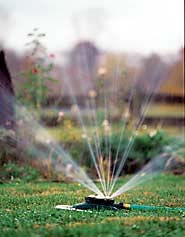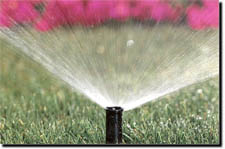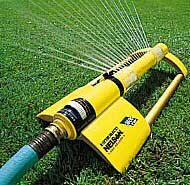
![]()



![]()
|
Automatic |
Manual |
|
|
Equipment Costs |
medium to high |
low |
|
at least annually |
rare |
|
|
Intensive |
none |
|
|
medium to high |
none |
|
|
little to no effort |
high effort |
|
|
complete area at once |
small sections at a time |
|
|
low to none |
high |
The benefits of the automatic system do not come at low costs to the homeowner. One cost to consider is the equipment costs. For an automatic system the equipment involved is rather extensive. There are timers, pressure regulators, valves, pipes, hoses, spray heads, rotors, bubblers, drip heads, and other various parts. With a manual system you need only to buy a garden hose or two and at most two different sprinkler heads.
![]()
The maintenance involved with a manual system is almost non existent. Replacement of a hose is rare when proper care is taken. With a small investment in high quality hoses and sprinklers, you may almost never find the need to replace the system components. However, with the automatic system, there is at the very minimum annual maintenance. This can be contracted out to a company that specializes in the installation and maintenance of automatic systems, or by reading the equipment manuals and with the proper tools, done by the homeowner. For an automatic system, the water must be blown out before each winter to prevent water freezing in the lines and permanently damaging the system. This should be done by a professional with the proper equipment so as not to damage the rotor heads. The eventual wear and tear from operation may also cause the need for replacement of parts within both systems.
![]()
The installation labor and costs for a manual system do not exist because there is no installation. Manual systems consist of a garden hose that is moved around the landscape by hand and then rolled back up into storage when not in use. For the automatic system costs can be quite intensive. It is best to have this professionally done if you have no experience with plumbing. This is a rather extensive process to burry the water lines and sprinkler heads under the ground safely. Professionals also have much better equipment such as a machine that can vibrate the pipes through the ground instead of digging a trench which will cause much less damage to the lawn. There are also expensive and important check valves, pressure regulators, and timers that must be installed. The timers require the knowledge of electricity and its installation throughout the system and into the house. If you are experienced with both plumbing and electricity than you can save a significant amount of money through a DIY installation. However, if you are not confident in your ability to do all of this, it is best to save the trouble and hassle by contracting a professional installer.
![]()
The operation of a manual system is much more intensive than that of the automatic system. The hose for a manual system must be kept somewhere when not in use. A special hose cart will keep the hose in the best condition and make transport much easier. They are available at almost any large hardware store. The manual system requires the monitoring of the water being applied and the movement of the sprinkler around the landscape to ensure coverage of the entire area. This is one of the main reasons why people decide to switch to an automatic system. The time and effort needed for the manual is not worth it to many people. With an automatic system you simply set the timers to turn the system on and off and you don't have to worry about moving anything around or checking to make sure everything is watered correctly. The best time to have the system turn on is in the very early morning. This allows the majority of the water to be taken in by the plants and earth before evaporating in the hot sun. Also this allows the excess water to dry off before fungus can get a chance to grow on the plants. This is a large problem with watering in the evening or night. Water that stays on the plants in the cool dark night allows fungus to grow rapidly and may quickly and severely damage plant life in the landscape.
![]()
As mentioned above, the coverage with a manual system is limited to the amount of sprinklers running at a given time. Usually there are no more than two which means that after a certain amount of time the sprinkler will have to be manually moved to another location and so on until the entire landscape has been covered. This method of watering will take hours to do and prevent the entire landscape from being watered in the crucial morning hours. On the contrary, the automatic system when installed and maintained correctly can cover the landscape perfectly. There are no areas that are left untouched. This is very beneficial to both water and time conservation.
![]()
The visibility of the manual system is quite obvious. There will be a hose caddy, several hoses and the sprinkler draped across the landscape taking away from the look. With the automatic system, there is virtually no visibility. The valves and other controls are buried in a box underground that can be covered with mulch to hid it until the next service. The pipes can be installed directly out of the basement into this box which will leave only the timers which can be placed in the garage or other inconspicuous place. The sprinkler heads themselves are only visible when the system is on. After the system shuts off the heads, which are spring loaded, will pop back under the surface of the landscape and remain hidden until the next use.
![]()






